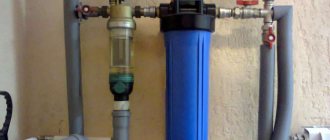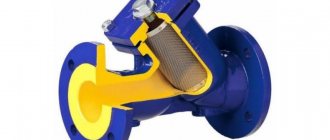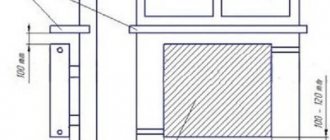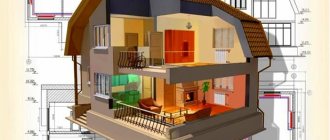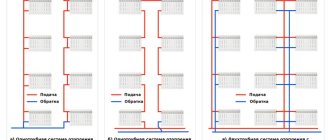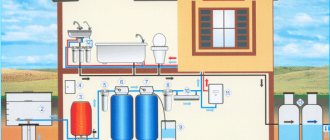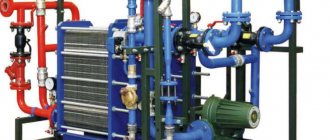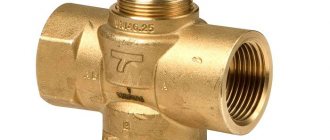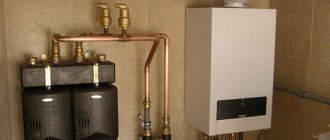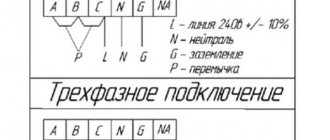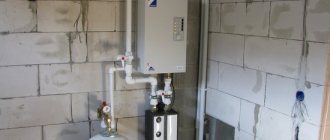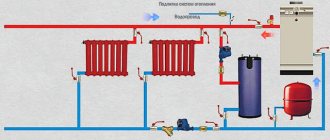Modern heating systems require timely maintenance as one of the conditions for long-term and trouble-free operation. And if in the components and systems of a heating boiler this is done using special equipment and equipment, then for the coolant and radiators such maintenance comes down to constantly maintaining cleanliness standards. This is where mud collectors for heating systems are needed - indispensable devices for preventing the sedimentation of sludge and dirt in pipes and radiators.
Why is it necessary to install mud traps in the heating system?
The need to install a mud trap in a heating system usually does not raise questions when repairing a system that has been operating for more than one year. Here you can clearly see that during operation, metal pipes gradually become clogged with rust, and the batteries have to be washed under high pressure of water using chemical cleaning agents.
In new systems, with polypropylene pipes and a modern boiler, it would seem that there is no need for such a device. But this is only at first glance. In reality, a heating system sump is necessary even in the newest systems.
There are several reasons to install such a filter:
- During the operation of the system, the coolant gradually changes its chemical properties, which means that chemical reactions occur inside the system, as a result of which insoluble substances are formed that can settle inside pipes and batteries;
- Small particles in a liquid, especially if they contain metal particles that can be attracted to each other and settle on other metal objects, for example, on pump blades, thereby gradually increasing the load on the engine pumping coolant;
- Sludge and debris can enter the system when filling coolant, for example, from tap water, and then settle on the inner walls of the pipes, narrowing the clearance for coolant circulation;
- During operation of the system, metal batteries and cast iron radiators gradually undergo corrosion, which is why rust particles are gradually discovered in the coolant flow.
So the only correct solution here would be to install a sump to periodically remove accumulated debris from the system.
Principle of operation
The work of a water sump pump is based on slowing down the flow rate.
- The liquid, entering the housing, begins to move more slowly due to an increase in the flow area. Impurities are filtered out and fall to the bottom under gravity.
- Water passes through a filter element located on the outlet pipe and enters the water supply system.
- Sludge is removed through the drain pipe at the bottom of the housing. When cleaning, also check the filter mesh for kinks, tears and damage.
For normal operation of the equipment, one condition must be met - a gradual increase in hydraulic resistance, which can be monitored by the indicators of instruments located before and after the mud trap.
Magnetic filters
To clean the hydraulic transport of heating systems, magnetic mud collectors, which appeared relatively recently, are also used. A magnet located inside the dirt trap pulls metallic inclusions out of the liquid and accumulates them in the reservoir. In this case, the device does not change the pressure in the pipes and does not slow down the water flow. Prevents the possibility of scale formation on the walls of pipeline fittings. Therefore, it can be installed on the suction sections of the pump.
The liquid here undergoes two-stage purification: coarse and fine. At the first stage, impurities larger than 500 microns are removed. The second contains smaller particles. During operation, a magnetic field is created, which helps soften the water and reduce the amount of salts.
Main types of filters and their design
Today, several designs of mud filters for heating systems have been developed. The principle of operation is similar for all - filtration of a coolant liquid, extraction of solid insoluble inclusions and their accumulation in a filter element or settling tank. Depending on the type of system, there are mud filters for industrial systems, and there are those that are used in individual heating installations, for example, in apartments or private houses.
Classification according to installation and cleaning method
Mud traps for heating systems are most often classified according to the method of installation in the system:
- On a threaded connection;
- Installed using flanges;
- Devices that require welding for installation;
New devices for plastic heating pipes are installed by soldering, so they can conditionally be classified as welded, although today they can be called a separate type of classification.
Classification according to the degree of purification divides filters into coarse filters and fine filters. The former are capable of capturing only large particles, but fine filters are capable of sifting out particles of several microns.
Classification by method of service
There is also a classification according to the method of maintenance, in other words, because the contents of the filter elements are cleaned:
- Self-cleaning;
- Flushing;
- Non-flush;
The former are cleaned by washing the mesh when opening the valve on the filter housing. All contents are simply discharged out through the valve. In washable filters, after removing the lid or flask, the filter element is removed and cleaned first with a brush and then washed with a stream of water. Non-flush ones require complete removal from the system and maintenance in workshops or replacement with a new mud collector.
For a specific heating system, it is also important how the coolant is cleaned.
The simplest and most common are mesh filters. In the body of the mud tank, the coolant passes through a stainless steel mesh and insoluble particles are retained on the metal. To clean the filter itself, washing is done by opening the valve on the body or removing the mesh from the filter bowl.
Strain filters are installed both in small installations and in industrial heating plants. The advantage of this type of device is its reliability and simplicity of design.
In addition to the usual mesh filter, mesh filters with self-cleaning and with the additional function of an air vent have recently begun to be used. In addition to the coarse filter, a separator filter made of a fine mesh network is installed in the housing, which ensures the separation of gas particles and removes them to the air vent. The operating efficiency of this type of device largely depends on the pressure in the line - the higher the pressure, the more effective the process of cleaning and degassing the coolant.
Magnetic filters are similar in design to mesh filters, the only difference being that magnets are installed around the mesh in the housing, which attract metal particles and rust.
Another type of device provides cleaning of the coolant using gravity. The filter housing is a large-diameter container in which pipes for inlet and outlet of coolant are installed at different heights. When entering a large-diameter settling filter, the liquid changes direction of movement, which results in the formation of numerous flows and turbulences. Heavy particles break off and settle to the bottom of the filter. Such installations are most often used in industrial boiler houses and heating plants.
Pros and cons of filter elements
The advantages of mud traps are to prevent clogging of the main components of the heating system (feed pump and boiler). The presence of filters eliminates the need to replace the coolant with a clean one, as well as the need to flush the heating system. Timely installation of the mud trap ensures high-quality heat transfer, increasing the operating period of the system several times. The main advantages of the mud collector are as follows:
- Significant savings in fuel resources.
- Protection of convective elements of boilers.
- Reducing the volume of consumed reagents for water purification.
The disadvantage of the mechanical principle of water treatment is manifested in the rapid clogging of the mesh filter with a high degree of contamination of the working fluid. To solve the problem, a combined filtering method is used, i.e. First, the magnetic principle is used to remove heavy particles, and then the mechanical principle is used to eliminate suspended ones. The strainer should be removed from the sump pan for cleaning. The element can be washed using the back pressure of the liquid.
Installation diagram of a mud trap in a heating system
The effectiveness of cleaning the coolant largely depends on how correctly the mud trap is installed in the heating system. A classic strainer is installed in front of the heating boiler on the return pipe. The coolant from the heat exchanger enters the pipes and then into the heating radiators; after cooling, it enters the boiler through the return pipe, passing through the pump. If you place a filter on a direct supply pipe, the dirt in the filter will slow down the movement of the coolant. In addition, when passing through the register, it is the cooled coolant that pushes debris particles through the pipes. So, mud traps for heating systems are installed only on the coolant return pipe.
To correctly install the mud trap, an arrow on its body indicates the direction of water movement; if installed incorrectly, debris will accumulate in the filter body, and not in the volume of the filter element.
Purpose of the expansion tank
The compensation tank of the heating system is designed to maintain the required pressure in the heating network. During thermal expansion of the liquid, excess coolant enters the container. If it were not there, this would lead to a significant excess of pressure in the pipeline and an emergency.
When the expanded coolant enters the tank, the pressure in the system normalizes. After the water has cooled, the liquid from the tank again enters the heating circuit. This ensures the stability of the indicator in the network regardless of the coolant temperature.
Expansion tank device
There are expansion tanks of open and closed type. The first variety is the simplest - it is an ordinary barrel with a lid. There is a pipe cut into it from below for connecting to the heating system, and on top there is a pipe for emergency drainage of the coolant into the sewer. An open expansion tank is installed at the highest point of the network.
How to properly clean and what filters are best to buy for your home
It is recommended to choose mud collectors for heating systems in a private home, listening to the advice of a specialist. So for heating systems where the principle of natural coolant circulation with an expansion tank and metal heating pipes is used, it is more convenient and easier to install a circulation pump and a flanged sump. For modern double-circuit boilers, mud collectors for heating systems can be installed in either a plastic or metal casing. For large volumes of systems, for example, for the installation of a private two-story cottage, mud collectors for heating systems with air exhaust and self-cleaning functions are recommended. This is due to a large amount of coolant and a large number of points potentially prone to saturating the system with sludge and rust.
As for care and maintenance, here you need to remember two basic rules - first, maintenance is carried out after the end of the heating season and before the start, after a trial fire. The second rule requires constant monitoring of the operation of the system - if the pressure in the system increases and the batteries remain cold, you must first clean the mud traps and bleed the formed air in the radiators, then repeat the procedure after 2-3 days to finally normalize the operation of the system.
The cleaning process itself usually takes a few minutes - you need to turn off the boiler, turn off the water supply, open the lid and remove the filter for washing in a regular filter, or open the valve and clean the contents of the tank under pressure.
As you can see, mud collectors for heating systems play an important role for the proper operation of all its elements. Therefore, neglecting the installation of a mud trap for the heating system is extremely unprofessional.
Specifications
| Mud collectors for heating systems | |||||||||
| Conditional diameter, DN | Weight | Conditional pressure | D.H. | DH1 | DH2 | H | H1 | h | L |
| 32 mm | 201.9 kg | 1.6 MPa | 159 mm | 32 mm | 32 mm | 1120 mm | 1168 mm | 700 mm | 850 mm |
| 40 mm | 16.3 kg | 1.6 MPa | 159 mm | 40 mm | 45 mm | 360 mm | 406 mm | 260 mm | 345 mm |
| 50 mm | 19.4 kg | 1.6 MPa | 159 mm | 57 mm | 57 mm | 410 mm | 456 mm | 290 mm | 365 mm |
| 65 mm | 29.4 kg | 1.6 MPa | 219 mm | 76 mm | 89 mm | 490 mm | 534 mm | 340 mm | 425 mm |
| 80 mm | 33.5 kg | 1.6 MPa | 219 mm | 89 mm | 108 mm | 525 mm | 569 mm | 375 mm | 425 mm |
| 100 mm | 62.2 kg | 1.6 MPa | 325 mm | 108 mm | 133 mm | 620 mm | 662 mm | 450 mm | 525 mm |
| 125 mm | 70.4 kg | 1.6 MPa | 325 mm | 133 mm | 159 mm | 690 mm | 732 mm | 470 mm | 525 mm |
| 150 mm | 118 kg | 1.6 MPa | 426 mm | 159 mm | 194 mm | 875 mm | 928 mm | 550 mm | 650 mm |
| 200 mm | 266.7 kg | 1.6 MPa | 530 mm | 219 mm | 273 mm | 1105 mm | 1163 mm | 700 mm | 850 mm |
| 250 mm | 266.7 kg | 1.6 MPa | 530 mm | 219 mm | 273 mm | 1105 mm | 1163 mm | 700 mm | 850 mm |
